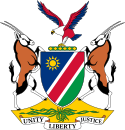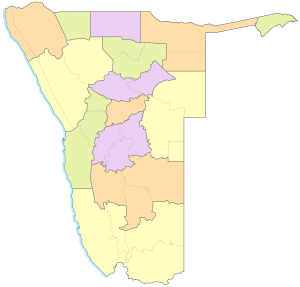Regions of Namibia
| Namibian Regions | |
|---|---|
 | |
| Category | Unitary state |
| Location | Republic of Namibia |
| Number | 14 |
| Populations | 71,233 (Omaheke) – 342,141 (Khomas) |
| Areas | 8,650 km2 (3,339 sq mi) (Oshana) – 161,510 km2 (62,361 sq mi) (ǁKaras Region) |
| Government |
|
| Subdivisions | |
 |
|---|
Namibia uses regions as its first-level subnational administrative divisions. Since 2013, it has 14 regions which in turn are subdivided into 121 constituencies.
Upon Namibian independence, the pre-existing subdivisions from the South African administration were taken over. Since then, demarcations and numbers of regions and constituencies of Namibia are tabled by delimitation commissions and accepted or declined by the National Assembly.
In 1992, the 1st Delimitation Commission, chaired by Judge President , proposed that Namibia should be divided into 13 regions. The suggestion was approved in the lower house, The National Assembly. In 2014, the 4th Delimitation Commission amended the number of regions to fourteen.[1]
| # | Region | Capital | Population (2011 census)[2] | Area (km2)[3] | Population density (persons/km2) |
|---|---|---|---|---|---|
| 1 | Kunene Region | Opuwo | 86,856 | 115,260 | 0.8 |
| 2 | Omusati Region | Outapi | 243,166 | 26,551 | 9.1 |
| 3 | Oshana Region | Oshakati | 176,674 | 8,647 | 20 |
| 4 | Ohangwena Region | Eenhana | 245,446 | 10,706 | 22 |
| 5 | Oshikoto Region | Omuthiya | 181,973 | 38,685 | 4.7 |
| 14 | Kavango West Region | Nkurenkuru | 107,905 | 23,166 | 4.7 |
| 6 | Kavango East Region | Rundu | 115,447 | 25,576 | 4.5 |
| 7 | Zambezi Region | Katima Mulilo | 90,596 | 14,785 | 6.1 |
| 8 | Erongo Region | Swakopmund | 150,809 | 63,539 | 2.4 |
| 9 | Otjozondjupa Region | Otjiwarongo | 143,903 | 105,460 | 1.4 |
| 10 | Omaheke Region | Gobabis | 71,233 | 84,981 | 0.8 |
| 11 | Khomas Region | Windhoek | 342,141 | 36,964 | 9.2 |
| 12 | Hardap Region | Mariental | 79,507 | 109,781 | 0.7 |
| 13 | ǁKaras Region | Keetmanshoop | 77,421 | 161,514 | 0.5 |
Regions 1990–1992[]

Southern
Ostcaprivi
Okahandja
Otjiwarongo
Eastern
Oshakati
North Central
Ondangwa
South Central
Kaoko
North Western
Western
Central
Kavango
See also[]
References[]
- ^ Immanuel, Shinovene (12 April 2012). "Caprivi is no more". The Namibian.
- ^ Namibia at GeoHive Archived 2012-05-22 at the Wayback Machine
- ^ "Namibia's Population by Region". Election Watch. Institute for Public Policy Research (1): 3. 2013.
- "Namibia 2001 Population and Housing Census". National Planning Commission. 2001. Archived from the original on 2012-01-11. Retrieved 2008-12-27.
Categories:
- Regions of Namibia
- Subdivisions of Namibia
- Lists of administrative divisions
- Administrative divisions in Africa
- First-level administrative divisions by country
- Namibia geography-related lists